Probably the most common question asked of window cleaners is ” What detergent do you use in your water ?”. We have tried many different products over the years to add to the water. Most people think that what goes in the water is the magic behind cleaning windows. In fact it is the microfibre applicator that puts the water on the glass. The squeegee that removes the water that is most important. That said it is important to use a chemical that is very neutral. This so as not to stain fabrics or carpets if any drops of water land on them. If there are some drips it must be easy to wipe up and not stain or bleach fabrics. Also it is important that rubber seals around windows, window frames and surrounding paint work is not affected by the window cleaning process. The window cleaners are subject to getting the solution on their hands and splashes on other parts of the body. So again it is important the washing solution be very neutral and not an aggressive cleaning product. The products we trust are Palmolive, Morning Fresh or Sunlight dishwashing liquid. Any good quality dishwashing detergent is fine. We use very small amounts, more is not better too much leaves a sticky residue on the glass that attracts dust. So next time you see a window cleaner it is not what detergent is in the water but the equipment and the operator that makes those windows sparkle.
Blog
Shop Front Window Cleaning
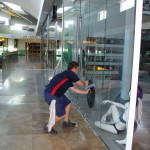 Shop front window cleaning is important to our business at All Clear Windows. We operate in all the main Gold Coast shopping centres and suburbs. We currently clean shops at Harbour Town at Biggera Waters, Homeworld at Helensvale, Runaway Bay Shopping Centre, Hope Island Marina, Australia Fair Southport, Pacific Fair Broadbeach, Robina Town Centre, Stocklands Burleigh Heads, Oracle shopping precinct at Broadbeach, Circle on Cavill in Surfers Paradise, High Street at the Sufers Paradise Hilton, Soul shopping precinct Surfers Paradise, Marina Mirage Main Beach and Q1 retail. Retail shop fronts are a way for businesses to highlight the merchandise they sell.
Shop front window cleaning is important to our business at All Clear Windows. We operate in all the main Gold Coast shopping centres and suburbs. We currently clean shops at Harbour Town at Biggera Waters, Homeworld at Helensvale, Runaway Bay Shopping Centre, Hope Island Marina, Australia Fair Southport, Pacific Fair Broadbeach, Robina Town Centre, Stocklands Burleigh Heads, Oracle shopping precinct at Broadbeach, Circle on Cavill in Surfers Paradise, High Street at the Sufers Paradise Hilton, Soul shopping precinct Surfers Paradise, Marina Mirage Main Beach and Q1 retail. Retail shop fronts are a way for businesses to highlight the merchandise they sell.
Pacific Fair is going through a $670 million redevelopment that started in January 2014 with a completion date around June 2016 creating an additional 120 stores bringing the total to around 420 including a new Big W, David Jones, Woolworths and 1300 new carparks. We are looking forward to servicing as many new shops as the redevelopment progresses.
A $20-MILLION redevelopment of Harbour Town will see an increase in car spaces, helping ease customer frustrations. Construction began at the Biggera Waters outlet shopping centre earlier this week to create 25 new shops as well as the new parking area. The former Bunnings building to the west of the centre has been demolished to make way for 400 new parking bays.
We service the surrounding areas to all the centres mentioned. We are in these centres on a regular basis usually weekly and can provide competitive prices.
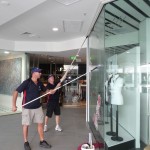 We are a local company not a national company. National companies are notorious for using subcontractors who often subcontract again to cleaners who are not fully insured. We are sometimes contracted by some national companies but we are fully insured. All of our staff are employed, uniformed, OH&S compliant and fully insured NOT subcontractors. We are available at short notice and happy to do inside window cleans, clean mirrors, sticky tape removal and signs.
We are a local company not a national company. National companies are notorious for using subcontractors who often subcontract again to cleaners who are not fully insured. We are sometimes contracted by some national companies but we are fully insured. All of our staff are employed, uniformed, OH&S compliant and fully insured NOT subcontractors. We are available at short notice and happy to do inside window cleans, clean mirrors, sticky tape removal and signs.
We are happy to help you work out a cleaning schedule to suit your needs and budget. Weekly, fortnightly, monthly cleans depending on your situation. When you call us for a quote you can expect an immediate response and know we have $20 million dollars public liability insurance and all staff are covered by work cover.
Window Cleaning Reverse Osmosis System
Pure Rinse Window Cleaning Reverse Osmosis System
The following is an explanation of the design concept for Pure Rinse R.O. systems that we use to clean windows and solar panels
Pre-filtration
Pure Rinse systems have oversized, triple pre-filtration housings and cartridges. The first cartridge is a five micron sediment filter. The second is an optional long life mixed media carbon cartridge or the standard carbon block cartridge to remove chlorine. The carbon cartridge protects the R.O. TFC (Thin Film Composite) membrane. Chlorine is very destructive to TFC membranes. The third cartridge is a one-micron final filter to remove remaining “fines”.
Triple pre-filtration increases initial price of our system. However, it reduces maintenance, operating cost and downtime. Payback for this incremental initial cost is less than one year or the first time you stop in the middle of a job to replace undersized cartridges.
The first filter, the five-micron cartridge, in the lowest cost filter and is replaced most often. Just how often is determined by the condition of the water. Gauges are provided to monitor pressure drop of water flowing through the filter. If water pressure coming out of the filter is 0-10 PSI less than water pressure entering the filter, then the filter is in good condition. If pressure drop is greater than 10 PSI, then replace the filter cartridge. These measurements are taken with unit running. When unit is not running all gauges should be exactly equal. If all gauges are not equal consider replacement.
The second filter is an optional mixed media carbon filter or our standard carbon block filter. Its function is to remove chlorine. Chlorine attacks TFC R.O. membranes. Mixed media carbon filter cartridges are four times more expensive than carbon block cartridges but last 10 times longer. There is no simple recommended service interval. For example, if you use well water with no chlorine you may never need replacement. If you are in an area of high chlorine content you should consider changing the carbon block cartridge every 1000 gallons or the mixed media cartridge every 10,000 gallons. Annual replacement, under normal conditions, is usually an adequate service interval.
The third filter is a one-micron final filter. It removes remaining sediment not removed by the five micron filter and carbon fines released by the carbon filter. Again, if pressure drop exceeds 10 PSI the filter cartridge should be replaced.
Filter cartridge replacement is completely determined by local water conditions.
A service interval for bad water (high chlorine and high TDS) areas might be:
Five micron pre-filter cartridge: replace at 10 hours running time
One micron final filter cartridge: replace at 20 hours running time
Carbon block cartridge: replace at 10 hours running time
Carbon mixed media cartridge: replace at 100 hours running time
Ten hours running time equals 1500 gallons of source water flowing through the pre-filtration system.
With our triple banked system, under ideal conditions, 70% of the 1500 gallons will be pure water, or approximately 1000 gallons.
A 50 gallon tank would be filled 20 times with 1000 gallons.
Well water has no chlorine. Therefore, carbon cartridges last a very long time. However, well water has high levels of sediment. Therefore, replacement of the 5 micron cartridge is required more often when using well water.
R.O. Membranes
Pure Rinse has selected HR (High Rejection) membranes for their system rather than HF (High Flow) membranes.
HR membranes run at higher pressure (150-200 PSI), produce less wastewater and have a 98-99% rejection rate. For example, if source water TDS (Total dissolved solids in parts per million) is 500 then the product water (pure water) out of the HR R.O. membrane would be 10 or less TDS (2% or less of 500 TDS). “SPOT FREE” rinsing requires TDS to be 10 or less.
In contrast, HF membranes run at low pressure (20-80 PSI) and have only a 90% rejection rate. Again, for example, if source water is 500 TDS then the product water (pure water) out of the HF membrane is 50 TDS (10% or less of 500 TDS). The advantage of the HF membrane system is it can operate with tap water pressure in areas with high tap water pressure (50 PSI or more). City water pressure is usually adequate, well water pressure is usually inadequate.
HF (high flow) membrane systems have several disadvantages:
1.) They require a secondary D.I. system to remove the higher residual TDS.
Residual TDS is ten times higher than that of HR (high rejection) systems.
2.) They rely on local water pressure to be above 50 PSI. Well water is usually 20-40 PSI.
3.) They use three times more water to produce pure water. This is because they are single pass systems and use the source water only once.
4.) They create more waste water. Manufacturers of membranes require 80% of source water flow to become waste water to avoid fouling and premature failure.
5.) The membrane fouls and needs replacement more often.
6.) They require three times the service and replacement of filter cartridges. The triple banked Pure Rinse HR system uses the source water three times, only 30% of source water flow becomes waste water.
The Pure Rinse HR membrane has a 98-99% rejection rate (reduces TDS to 1 or 2% incoming water). In areas where local water conditions are 500 TDS or lower no D.I. final “polishing” of pure water is required. In areas where TDS in greater than 500, we recommend our “polishing” attachment, “THE ZERO”. This is an optional D.I. cartridge in a filter housing to be used, as required, in areas of high TDS water.
“THE ZERO” polishing attachment is a simple and relatively low cost alternative to using D.I. tanks that are required with the HF membrane system.
Remember, the HF (High Flow), membrane leaves 10 times the residual TDS than the HR (High rejection) membrane. The service life of the final “polishing” D.I. cartridge in the HR system will last ten times longer than a D.I. cartridge in the HF system. Again, the HR system has only 1/10 the residual TDS of the HF system.
For example, the capacity of our D.I. polishing cartridge is 18,000 TDS. If incoming water to the D.I. Cartridge has a TDS of 10, the cartridge would be good for 1800 gallons. If incoming water to the D.I. Cartridge is 100, the cartridge would only be good for 180 gallons.
D.I. tanks are expensive, bulky and a nuisance. Frequent replacement of D.I. cartridges is also expensive.
HR systems have a substantial operating cost advantage and are more reliable.
Window Cleaning Maintenance Schedule
We have many years experience working with building and department managers, executive house keepers, body corporate managers, rental managers for real estate companies helping them to achieve a cost effective window cleaning maintenance schedule. We can assist with planning and working within budgets. Often cleaning budgets are the first to receive cutbacks and within the cleaning budget window cleaning is the first to get cutback or the frequency of cleans is extended. Dirty windows are often the first thing people notice when they stay in hotels, holiday high-rises or any rental accommodation. In many cases the cleaning staff do not have time or the skills to maintain the glass to a standard that is expected by customers paying good money to enjoy the fabulous views of the beach and water views that the Gold Coast is famous for.
We are able to put together a window cleaning schedule with a variety of options and frequencies so a suitable daily/weekly/monthly program can be created to meet your needs and budget.
This enables managers to make informed decisions and recommendations to body corporate committees and upper management so that buildings can be maintained the highest standard within budget constraints.
Aluminium Window Maintenance and Corrosion Prevention
Aluminium window maintenance and corrosion prevention including doors and balustrades is often overlooked. All glass surfaces must be kept clean by removing all dirt and deposits. Clean water with a small amount of detergent gives the most impressive results. Preferably squeegee the glass off, don’t use any abrasive cleaners or scourers as these can scratch the glass and aluminium frames. Scratched glass is really expensive to fix but not impossible
Many people think that aluminium does not corrode however it does and once it starts it is very aggressive especially anywhere near to the sea. Cleaning aluminium window frames, sills, tracks is very important as aluminium does corrode. This corrosion is far more evident the closer you get to the ocean, as salt air is very corrosive. We have spent more than 15 years cleaning windows in coastal suburbs and it never fails to amaze me how much corrosion there is on the aluminium surrounding the windows and doors.
Three-storey walkups and high-rises close to the beach are especially prone due to proximity to the salt air and because many windows are difficult to access. Anywhere there are balconies the sliding windows and doors have a tendency to be cleaned and maintained more regularly because they’re easy to get at. Frequently the untouched windows can only really be accessed from the ledge and in many cases there’s no ledge or access . In these cases the corrosion goes on for years and years to the point at which the only cure is replacing the windows. Windows and doors are being replaced along the coastal strip all the time, often entire buildings at a time. A time consuming and money hungry operation, manufacturers offer a warranty with a condition that the windows and frames are cleaned regularly as per their recommendations. Window makers recommend regular cleaning of windows and frames, the closer to the ocean the more regular the cleans need to be. Buildings close to the beach it is recommended the cleaning be carried out at 3 month intervals further inland 6 monthly is advised. Check with window manufacturers for their recommendations.
Balustrades and handrails on balconies are mostly made from aluminium. These are usually attached to the concrete floor in most cases and handrails often bolted to the wall at either end. A lot time is spent resting against or leaning on handrails taking in the views particularly in holiday high-rises along the coast where people make the very most of the balconies for outdoor entertainment. Much of our work is in high-rises so we get to see the good and the bad. There does not seem to be any consistent preventative maintenance on the key connection points of balustrades and handrails. Corrosion must kept to a minimum to ensure balconies are safe to use at all times.
Regular upkeep of all window and door hardware including locks latches drop-bolts and rollers is very important. Window hinges become really stiff so more force is needed to open the window next thing something breaks. This has happened to us on more than one occasion cleaning windows on high-rise buildings. Result being left with a window that is hanging on by just one hinge.
The aluminium should be cleaned and then hinges and latches lubricated. It is then advised to wipe over the external aluminium surfaces with a cloth moistened with WD 40 or Inox or lanolin based product. We have found Inox products superb in these situations. Again the closer to the coast the more regular the maintenance should be 3 monthly close to the coast 6 monthly further inland. Some buildings we have been involved with over the years have had regular maintenance of window and door surrounds with great results. The main benefit is many years extended life for windows sliding doors and balustrades.
Pure Water Window Cleaning
Is it possible to have windows cleaned using pure water only?
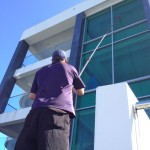 Yes ! Pure water window cleaning. No soap, detergent or other chemicals used. How is this possible? Many companies now provide this service. First of all we have to know what does “pure water” mean. Pure water is a purified sort of water free from all contaminants and substances like magnesium, calcium, salt and the like. These tiny deposits in the water are left when water evaporates. These can be frequently seen on glass bathroom shower screens and external windows that are hosed with normal tap water. A lot of vehicles that are washed and not dried off or washed with pure water also end up with spots. To obtain pure water standard tap water must go through a purification process. One of the most common yet effective filtration processes currently available is reverse osmosis (RO). In a reverse osmosis system, regular tap water is passed thru a semi-permeable membrane whereby salt, minerals are rejected and don’t pass through the membrane. The water that passes through the membrane becomes pure water. Salt and minerals in tap water is generally known as Total Dissolved Solids (TDS) which is commonly voiced as mg per litre (mg/L) or parts per million (ppm). TDS is the measure of the purity of water. For a good running reverse osmosis system, it is expected that 85-to-99% of TDS will be reduced. We have found a TDS reading should be between 1 and 10 to give the spot free finish that’s required.
Yes ! Pure water window cleaning. No soap, detergent or other chemicals used. How is this possible? Many companies now provide this service. First of all we have to know what does “pure water” mean. Pure water is a purified sort of water free from all contaminants and substances like magnesium, calcium, salt and the like. These tiny deposits in the water are left when water evaporates. These can be frequently seen on glass bathroom shower screens and external windows that are hosed with normal tap water. A lot of vehicles that are washed and not dried off or washed with pure water also end up with spots. To obtain pure water standard tap water must go through a purification process. One of the most common yet effective filtration processes currently available is reverse osmosis (RO). In a reverse osmosis system, regular tap water is passed thru a semi-permeable membrane whereby salt, minerals are rejected and don’t pass through the membrane. The water that passes through the membrane becomes pure water. Salt and minerals in tap water is generally known as Total Dissolved Solids (TDS) which is commonly voiced as mg per litre (mg/L) or parts per million (ppm). TDS is the measure of the purity of water. For a good running reverse osmosis system, it is expected that 85-to-99% of TDS will be reduced. We have found a TDS reading should be between 1 and 10 to give the spot free finish that’s required.
How is the pure water window cleaning done ?
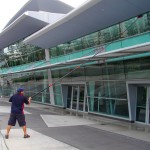 The pure water is stored in a holding tank that is mounted on the specialists truck or made and used onsite depending on the filtration unit. The water is then pumped up an extendable pole that has a brush on the end. The windows are brushed gradually, loosening the dirt then rinsed off with the water. These extension poles are called water fed poles which have been around for many years. The newest poles are made of carbon fibre/graphite mixtures making them a lot lighter and easier to use. These water fed poles are used together with pure water and have been a real game changer.
The pure water is stored in a holding tank that is mounted on the specialists truck or made and used onsite depending on the filtration unit. The water is then pumped up an extendable pole that has a brush on the end. The windows are brushed gradually, loosening the dirt then rinsed off with the water. These extension poles are called water fed poles which have been around for many years. The newest poles are made of carbon fibre/graphite mixtures making them a lot lighter and easier to use. These water fed poles are used together with pure water and have been a real game changer.
What are the advantages of using pure water for window cleaning?
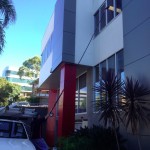 When pure water is used for cleaning windows you finish up with a spot free finish on the glass. Using extendable water fed poles significantly decreases or gets rid of the need for ladders which in turn makes the work place a lot safer. This could reduce insurance claims, eliminating the chance of someone falling off a ladder. No chemicals are involved in the procedure, such as detergent or cleaning agents that are routinely used with conventional techniques. This cleaning method is ecologically friendly.
When pure water is used for cleaning windows you finish up with a spot free finish on the glass. Using extendable water fed poles significantly decreases or gets rid of the need for ladders which in turn makes the work place a lot safer. This could reduce insurance claims, eliminating the chance of someone falling off a ladder. No chemicals are involved in the procedure, such as detergent or cleaning agents that are routinely used with conventional techniques. This cleaning method is ecologically friendly.

Follow Us!